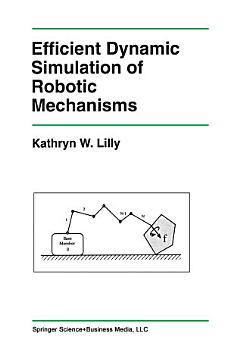Efficient Dynamic Simulation of Robotic Mechanisms
Kathryn Lilly
2012. g. dec. · The Springer International Series in Engineering and Computer Science 203. grāmata · Springer Science & Business Media
E-grāmata
136
Lappuses
reportAtsauksmes un vērtējumi nav pārbaudīti. Uzzināt vairāk
Par šo e-grāmatu
Efficient Dynamic Simulation of Robotic Mechanisms presents computationally efficient algorithms for the dynamic simulation of closed-chain robotic systems. In particular, the simulation of single closed chains and simple closed-chain mechanisms is investigated in detail. Single closed chains are common in many applications, including industrial assembly operations, hazardous remediation, and space exploration. Simple closed-chain mechanisms include such familiar configurations as multiple manipulators moving a common load, dexterous hands, and multi-legged vehicles. The efficient dynamics simulation of these systems is often required for testing an advanced control scheme prior to its implementation, to aid a human operator during remote teleoperation, or to improve system performance.
In conjunction with the dynamic simulation algorithms, efficient algorithms are also derived for the computation of the joint space and operational space inertia matrices of a manipulator. The manipulator inertia matrix is a significant component of any robot dynamics formulation and plays an important role in both simulation and control. The efficient computation of the inertia matrix is highly desirable for real-time implementation of robot dynamics algorithms. Several alternate formulations are provided for each inertia matrix.
Computational efficiency in the algorithm is achieved by several means, including the development of recursive formulations and the use of efficient spatial transformations and mathematics. All algorithms are derived and presented in a convenient tabular format using a modified form of spatial notation, a six-dimensional vector notation which greatly simplifies the presentation and analysis of multibody dynamics. Basic definitions and fundamental principles required to use and understand this notation are provided. The implementation of the efficient spatial transformations is also discussed in some detail. As a means of evaluating efficiency, the number of scalar operations (multiplications and additions) required for each algorithm is tabulated after its derivation. Specification of the computational complexity of each algorithm in this manner makes comparison with other algorithms both easy and convenient.
The algorithms presented in Efficient Dynamic Simulation of Robotic Mechanisms are among the most efficient robot dynamics algorithms available at this time. In addition to computational efficiency, special emphasis is also placed on retaining as much physical insight as possible during algorithm derivation. The algorithms are easy to follow and understand, whether the reader is a robotics novice or a seasoned specialist.
In conjunction with the dynamic simulation algorithms, efficient algorithms are also derived for the computation of the joint space and operational space inertia matrices of a manipulator. The manipulator inertia matrix is a significant component of any robot dynamics formulation and plays an important role in both simulation and control. The efficient computation of the inertia matrix is highly desirable for real-time implementation of robot dynamics algorithms. Several alternate formulations are provided for each inertia matrix.
Computational efficiency in the algorithm is achieved by several means, including the development of recursive formulations and the use of efficient spatial transformations and mathematics. All algorithms are derived and presented in a convenient tabular format using a modified form of spatial notation, a six-dimensional vector notation which greatly simplifies the presentation and analysis of multibody dynamics. Basic definitions and fundamental principles required to use and understand this notation are provided. The implementation of the efficient spatial transformations is also discussed in some detail. As a means of evaluating efficiency, the number of scalar operations (multiplications and additions) required for each algorithm is tabulated after its derivation. Specification of the computational complexity of each algorithm in this manner makes comparison with other algorithms both easy and convenient.
The algorithms presented in Efficient Dynamic Simulation of Robotic Mechanisms are among the most efficient robot dynamics algorithms available at this time. In addition to computational efficiency, special emphasis is also placed on retaining as much physical insight as possible during algorithm derivation. The algorithms are easy to follow and understand, whether the reader is a robotics novice or a seasoned specialist.
Novērtējiet šo e-grāmatu
Izsakiet savu viedokli!
Informācija lasīšanai
Viedtālruņi un planšetdatori
Instalējiet lietotni Google Play grāmatas Android ierīcēm un iPad planšetdatoriem/iPhone tālruņiem. Lietotne tiks automātiski sinhronizēta ar jūsu kontu un ļaus lasīt saturu tiešsaistē vai bezsaistē neatkarīgi no jūsu atrašanās vietas.
Klēpjdatori un galddatori
Varat klausīties pakalpojumā Google Play iegādātās audiogrāmatas, izmantojot datora tīmekļa pārlūkprogrammu.
E-lasītāji un citas ierīces
Lai lasītu grāmatas tādās elektroniskās tintes ierīcēs kā Kobo e-lasītāji, nepieciešams lejupielādēt failu un pārsūtīt to uz savu ierīci. Izpildiet palīdzības centrā sniegtos detalizētos norādījumus, lai pārsūtītu failus uz atbalstītiem e-lasītājiem.







